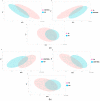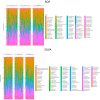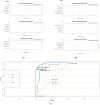Characteristics of the Gut Microbiota in Regard to Atopic Dermatitis and Food Allergies of Children
- PMID: 38540166
- PMCID: PMC10967912
- DOI: 10.3390/biomedicines12030553
Characteristics of the Gut Microbiota in Regard to Atopic Dermatitis and Food Allergies of Children
Abstract
The gut microbiota plays an important role in maintaining human health, as well as in the development of various pathologies, as indicated by a large amount of research. One of the manifestations of an imbalance in the gut microbiome composition is the appearance of various diseases or immune reactions, in particular, atopic dermatitis (AD) and/or food allergies (FA). In this research, using 16S NGS sequencing, it was found that the gut microbiome of children with food allergies and children with atopic dermatitis can be characterized as having higher inflammatory potential. Both groups exhibited an abundance of representatives from the Pasteurellaceae and Erysipelotrichaceae families, as well as a decrease in the relative number of representatives from the Barnesiellaceae family compared to healthy participants. In the group of participants with food allergies, there was a decrease in the relative number of Desulfovibrionaceae representatives and Bifidobacteriaceae family enrichment in relatively healthy participants. In addition, when comparing this group with patients with atopic dermatitis, it was revealed that a number of representatives of such families as Erysipelotrichaceae, Ruminococcaceae and Sutterellaceae prevailed. This information confirms that AD and FA correlate with changes in the composition of the gut microbiota. Further research is needed to determine the cause-effect connections and the effect of compounds derived from the microbiota on the AD and FA development and progression, as well as to create new probiotic drugs to prevent and modulate immune responses, including at an early age.
Keywords: 16S rRNA; atopic dermatitis; atopy; dysbiosis; food allergy; gut microbiota; microbial diversity; microbiome.
Conflict of interest statement
The authors declare no conflict of interest.
Figures





Similar articles
-
The Association between Gut Microbiota and Serum Biomarkers in Children with Atopic Dermatitis.Biomedicines. 2024 Oct 15;12(10):2351. doi: 10.3390/biomedicines12102351. Biomedicines. 2024. PMID: 39457662 Free PMC article.
-
A Combined Analysis of Gut and Skin Microbiota in Infants with Food Allergy and Atopic Dermatitis: A Pilot Study.Nutrients. 2021 May 15;13(5):1682. doi: 10.3390/nu13051682. Nutrients. 2021. PMID: 34063398 Free PMC article.
-
Dysbiosis involving methionine and PPAR-γ pathways is associated with early onset atopic dermatitis and food allergy.Asian Pac J Allergy Immunol. 2025 Feb 16. doi: 10.12932/AP-131223-1749. Online ahead of print. Asian Pac J Allergy Immunol. 2025. PMID: 39955638
-
Gut microbiota modulation: a key determinant of atopic dermatitis susceptibility in children.Front Microbiol. 2025 Apr 28;16:1549895. doi: 10.3389/fmicb.2025.1549895. eCollection 2025. Front Microbiol. 2025. PMID: 40356648 Free PMC article. Review.
-
Relationship between Gut Microbiota and Allergies in Children: A Literature Review.Nutrients. 2023 May 29;15(11):2529. doi: 10.3390/nu15112529. Nutrients. 2023. PMID: 37299492 Free PMC article. Review.
Cited by
-
Advances in research on gut microbiota and allergic diseases in children.Curr Res Microb Sci. 2025 Feb 18;8:100362. doi: 10.1016/j.crmicr.2025.100362. eCollection 2025. Curr Res Microb Sci. 2025. PMID: 40123594 Free PMC article. Review.
-
Nutritional and Microbial Strategies for Treating Acne, Alopecia, and Atopic Dermatitis.Nutrients. 2024 Oct 20;16(20):3559. doi: 10.3390/nu16203559. Nutrients. 2024. PMID: 39458553 Free PMC article. Review.
-
Gut microbiota profile and atopic dermatitis in the first year of life.J Med Life. 2024 Oct;17(10):948-952. doi: 10.25122/jml-2024-0287. J Med Life. 2024. PMID: 39720170 Free PMC article.
-
Specific Gut Microbiome Signatures in Children with Cow's Milk Allergy.Nutrients. 2024 Aug 18;16(16):2752. doi: 10.3390/nu16162752. Nutrients. 2024. PMID: 39203888 Free PMC article.
-
The Association between Gut Microbiota and Serum Biomarkers in Children with Atopic Dermatitis.Biomedicines. 2024 Oct 15;12(10):2351. doi: 10.3390/biomedicines12102351. Biomedicines. 2024. PMID: 39457662 Free PMC article.
References
-
- Dierick B.J.H., van der Molen T., Flokstra-de Blok B.M.J., Muraro A., Postma M.J., Kocks J.W.H., van Boven J.F.M. Burden and Socioeconomics of Asthma, Allergic Rhinitis, Atopic Dermatitis and Food Allergy. Expert Rev. Pharmacoecon. Outcomes Res. 2020;20:437–453. doi: 10.1080/14737167.2020.1819793. - DOI - PubMed
-
- Sokolova T., Davidenko M. Statistics of Prevalence and Sickness Rate at Atopic Dermatitis of Children and Teenagers: Pro and Contra. Immunopathol. Allergol. Infectol. 2019;1:80–88. doi: 10.14427/jipai.2019.1.80. - DOI
-
- Justiz Vaillant A.A., Modi P., Jan A. StatPearls. StatPearls Publishing; Treasure Island, FL, USA: 2023. Atopy.
Grants and funding
LinkOut - more resources
Full Text Sources

